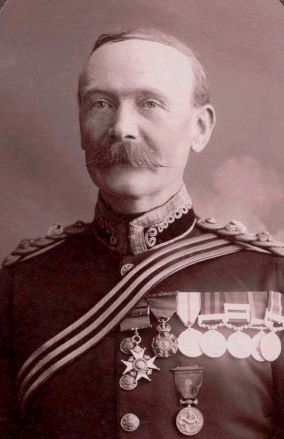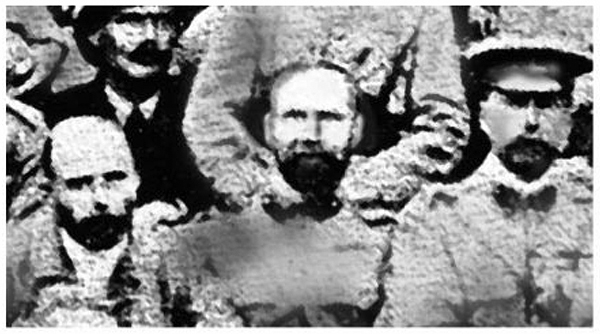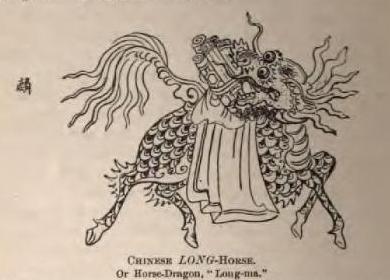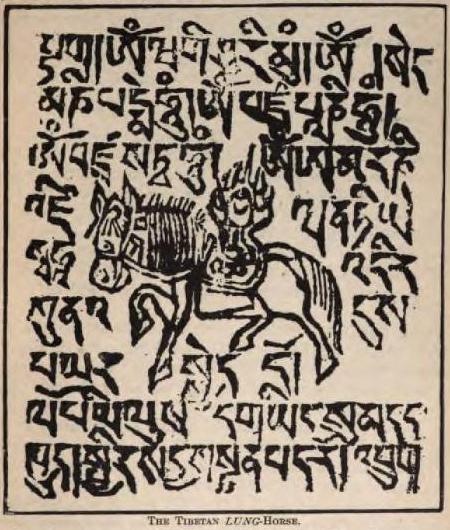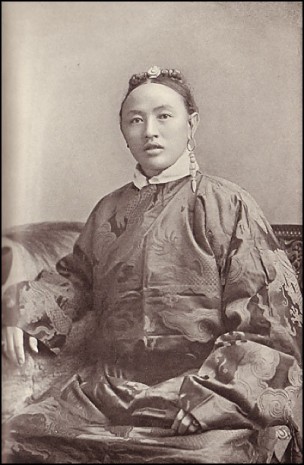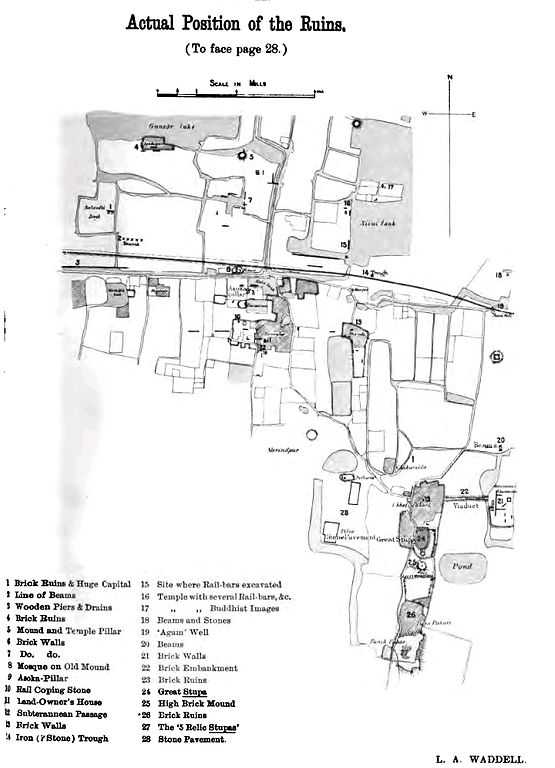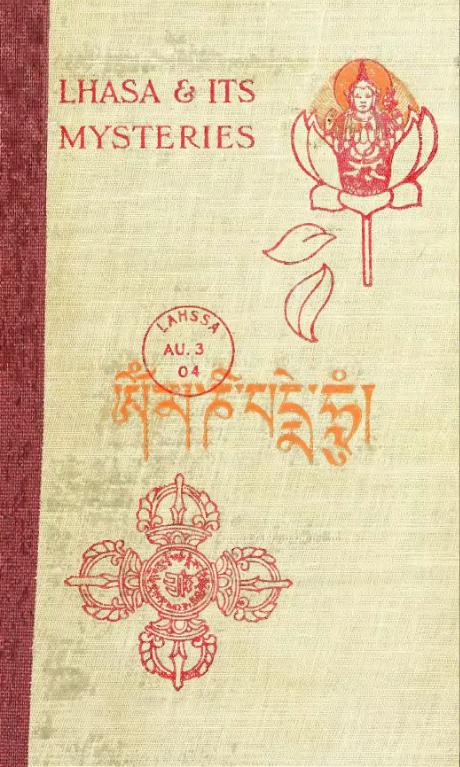
| LT. COL. LAURENCE A. WADDELL
Lt. Col. Laurence Austine Waddell
British Army officers in Tibet during 1904, Laurence Waddell (center) Lieutenant Colonel Laurence Austine Waddell, CB, CIE, F.L.S., L.L.D, M.Ch., I.M.S. RAI, F.R.A.S (1854–1938) was a Scottish explorer, Professor of Tibetan, Professor of Chemistry and Pathology, Indian Army surgeon, collector in Tibet, and amateur archaeologist. Waddell also studied Sumerian and Sanskrit; he made various translations of seals and other inscriptions. His reputation as an Assyriologist gained little to no academic recognition and his books on the history of civilization have caused controversy. Some of his book publications however were popular with the public, and he is regarded by some today to have been a real-life precursor of the fictional character Indiana Jones.
Life :
A Chinese Horse-Dragon, Reproduced in Waddell's, "The Buddhism of Tibet: Or Lamaism, with Its Mystic Cults, Symbolism and Mythology ...", 1895. Unknown Chinese artist.
A Tibetan Lung-Horse, Reproduced in Waddell's, "The Buddhism of Tibet: Or Lamaism, with Its Mystic Cults, Symbolism and Mythology ...", 1895. Unknown Tibetan artist.
A photo of Paljor Dorje Shatra, Reproduced in Waddell's "Lhasa and Its Mysteries-With a Record of the British Tibetan Expedition of 1903–1904", 1905. Laurence Waddell was born on 29 May 1854, and was the son of Rev. Thomas Clement Waddell, a Doctor of Divinity at Glasgow University and Jean Chapman, daughter of John Chapman of Banton, Stirlingshire. Laurence Waddell obtained a bachelor's degree in Medicine followed by a master's degree in both Surgery and Chemistry at Glasgow University in 1878. His first job was as a resident surgeon near the university and was also the President of Glasgow University's Medical Society. In 1879 he visited Ceylon and Burma and was 'irresistibly attracted' towards Buddhism which in later years led him to study the tenets, history and art of Buddhism. In 1880 Waddell joined the British Indian Army and served as a medical officer with the Indian Medical Service (I.M.S), subsequently he was stationed in India and the Far East (Tibet, China and Burma). The following year he became a Professor of Chemistry and Pathology at the Medical College of Kolkata, India. While working in India, Waddell also studied Sanskrit and edited the Indian Medical Gazette. He became Assistant Sanitary Commissioner under the government of India.
After Waddell worked as a Professor of Chemistry and Pathology for 6 years, he became involved in military expeditions across Burma and Tibet. Between 1885–1887 Waddell took part in the British expedition that annexed Upper Burma, which defeated Thibaw Min the last king of the Konbaung dynasty. After his return from Burma Waddell was stationed in Darjeeling district, India, and was appointed Principal Medical Officer in 1888. In the 1890s Waddell, while in Patna, established that Agam Kuan was part of Ashoka's Hell. His first publications were essays and articles on medicine and zoology, most notably "The Birds of Sikkim" (1893). In 1895 he obtained a doctorate in law.
Map of 1895 excavations by Laurence Waddell at Pataliputra Waddell traveled extensively in India throughout the 1890s (including Sikkim and areas on the borders of Nepal and Tibet) and wrote about the Tibetan Buddhist religious practices he observed there. Stationed with the British army in Darjeeling, Waddell learned the Tibetan language and even visited Tibet several times secretly, in disguise. He was the cultural consultant on the 1903–1904 British invasion of Tibet led by Colonel Sir Francis Edward Younghusband, and was considered alongside Sir Charles Bell as one of the foremost authorities on Tibet and Tibetan Buddhism. Waddell studied archaeology and ethnology in-between his military assignments across India and Tibet, and his exploits in the Himalayas were published in his highly successful book Among the Himalayas (1899). Various archaeological excavations were also carried out and supervised by Waddell across India, including Pataliputra, of which he did not receive recognition of discovery until long after his death, in 1982, by the government of Bengal. His discoveries at Pataliputra were published in an official report in 1892.
During the 1890s Waddell specialised in Buddhist antiquities and became a collector, between 1895–97 he published "Reports on collections of Indo-Scythian Buddhist Sculptures from the Swat Valley", in 1893 he also read a paper to the International Congress of Orientalists: "On some newly found Indo-Grecian Buddhistic Sculptures from the Swat Valley". In 1895 Waddell published his book Buddhism of Tibet or Lamaism, which was one of the first works published in the west on Buddhism. As a collector, Waddell had come across many Tibetan manuscripts and maps, but was disappointed to not find a single reference to a lost ancient civilization, which he had hoped to discover.
Waddell continued his military service with the Indian Medical Service. He was in China during the Boxer Rebellion (1898–1901), including the Relief of Peking in August 1900, for which he was mentioned in despatches, received the China War Medal (1900) with clasp, and was in 1901 appointed a Companion of the Order of the Indian Empire (CIE). By late 1901 he had moved to North-West Frontier Province and was present during the Mahsud-Waziri Blockade, 1901–1902. He was in Malakand in 1902 and took part in the Tibet Mission to Lhasa 1903–04, for which he was again mentioned in despatches, received a medal with clasp and was appointed a Companion of the Order of the Bath (CB). Waddell then returned to England, where he briefly became Professor of Tibetan at the University College of London (1906–1908).
In 1908, Waddell began to learn Sumerian. Thus in his later career he turned to studying the ancient near east, especially Sumeria and dedicated his time to deciphering or translating ancient cuneiform tablets or seals, most notably including the Scheil dynastic tablet. In 1911, Waddell published two entries in the Encyclopædia Britannica. By 1917, Waddell was fully retired and first started exclusively writing on Aryans, beginning in an article published in the Asiatic Review entitled "Aryan Origin of the World's Civilization". From the 1920s Waddell published several works which attempted to prove an Aryan (i.e., Indo-European) origin of the alphabet and the appearance of Indo-European myth figures in ancient Near Eastern mythologies (e.g., Hittite, Sumerian, Babylonian). The foundation of his argument is what he saw as a persistence of cult practices, religious symbols, mythological stories and figures, and god and hero names throughout Western and Near Eastern civilizations, but also based his arguments on his deciphered Sumerian and Indus-Valley seals, and other archaeological findings.
Waddell died in 1938. That same year, he had completed writing Trojan Origin of World Civilization. The book was never published.
Discovery
of Buddha's Birthplace :
Waddell's
theories :
Phoenicians
:
According to Waddell the "unknown" script on the Newton Stone is Hitto-Phoenician. His translation is as follows :
"This Sun-Cross (Swastika) was raised to Bil (or Bel, the God of Sun-Fire) by the Kassi (or Cassi-bel[-an]) of Kast of the Siluyr (sub-clan) of the "Khilani" (or Hittite-palace-dwellers), the Phoenician (named) Ikar of Cilicia, the Prwt (or Prat, that is 'Barat' or 'Brihat' or Brit-on)."
Brutus of Troy, Waddell also regarded to be a real historical figure. In a chapter entitled "COMING OF THE "BRITONS" OR ARYAN BRITO-PHOENICIANS UNDER KING BRUTUS-THE-TROJAN TO ALBION ABOUT 1103, B.C", Waddell writes:
"This migration of King Brutus and his Trojan and Phoenician refugees from Asia Minor and Phoenicia to establish a new homeland colony in Albion, which event the British Chronicle historical tradition places at 1103 B.C. was probably associated with, and enforced by, not merely the loss of Troy, but also by the massacring invasion of Hittite Asia Minor, Cilicia and the Syria-Phoenician coast of the Mediterranean by the Assyrian King Tiglath Pileser I. about 1107 B.C. to 1105 B.C."
Reception :
Book cover "Lhasa and its Mysteries" 3rd edition in 1906 Waddell's contemporaries reviewed the book very negatively. One reviewer considered the content to be "admirable fooling", but that he had "an uneasy feeling that the author really believes it". It has also been pointed out that Waddell took the Historia Regum Britanniae to be literal history which is why he was almost asking to be ridiculed by historians:
"Contrary to the general opinion of historians, he [Waddell] accepts as authentic the chronicle of Geoffrey of Monmouth, and regards as historical the legend of King Brut of Troy having reached Britain with his followers about the year 1103 BC, founded London a few years later, and spread through the land Phoenician culture, religion and art [...] His views indeed are so unorthodox that he is no doubt prepared for strong criticism, and even ridicule. King Brut of Troy has long been relegated to the company of old wives' tales."
Indus-Valley
seals :
Reception
:
"However, a shift, which made his [Waddell's] claim appear untenable, occurred in the consensus in archaeology after Sir Mortimer Wheeler was put in charge of the Archaeological Survey of India [...] Wheeler's interpretation of the archaeological data was the guideline for scholars who appear to have ruled out the possibility that the language of the seals could be akin to Sumerian and Proto-Elamite."
Sumerian
language :
Reception
:
"The author [Waddell] has slight knowledge of Sumerian, and commits unpardonable mistakes [...] The meanings assigned to Sumerian roots are almost entirely erroneous. One can only regret the publication of such fantastic theories, which cannot possibly do service to serious science in any sense whatsoever."
Chronology
:
Reception
:
"The reader does not need to peruse this work very far to become aware of its distinct bias and unscientific method. Fortunately the 'Nordic race-mongers' have become discredited that there is little to fear from the effect of this opus on the intelligent lay public. Succinctly, Mr. Waddell believes that the beginning of all civilization dates from the Nordic [Aryan] Sumerians who were blond Nordics with blue eyes."
Waddell during his own life, was deemed to be anachronistic by most scholars because of his supremacist views regarding the Aryan race:
"One of the reasons for the literary oblivion of Waddell's works on the history of civilization with an Aryan theme is [...] in relation to the fact that he did not give up the quest for the Aryans in terms of racial origins when it was abandoned in the 1870s, and it was very influential in his choice of career [...] His comparative studies and decipherment led him to a completely controversial and alternative perspective of ancient history. Furthermore, the titles that are now little known may have been sidelined due his use of the term 'Aryan' as it became associated with the rise of Nazism."
Pan-Sumerism
:
Grafton Elliot Smith who pioneered hyperdiffusionism (but of the Egyptians) was an influential correspondent to Waddell.
Reception
:
"Waddell's hopes of rewriting the story of civilization with the Aryan race as the first and only protagonist rapidly faded as his works and ideas remained restricted to, if well rooted in, the ultra right wing fringes of society and scholarship. J. H. Harvey, member of the pro-Nazi Imperial Fascist League and later a respected medievalist, wrote a short book The Heritage of Britain (1940) which aimed to summarise Waddell's works for a narrower audience on the fringes of the British Fascist movement (Macklin 2008). The British-Israelite W. T. F. Jarrold used Waddell's study of the Newton Stone to support a Biblical origin for the Anglo-Saxon race (1927). Today Waddell's works are read and referenced most commonly by white supremacists, esoteric scholars and conspiracy theorists such as David Icke (1999)."
Collections
:
Tribute
:
Published books :
Sources :
Source
: |
